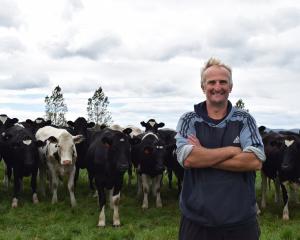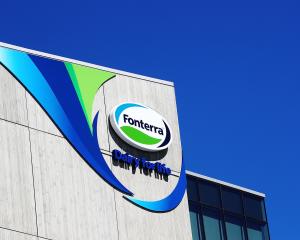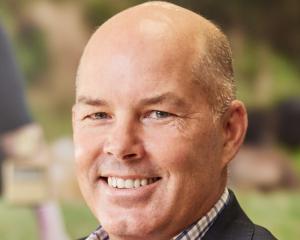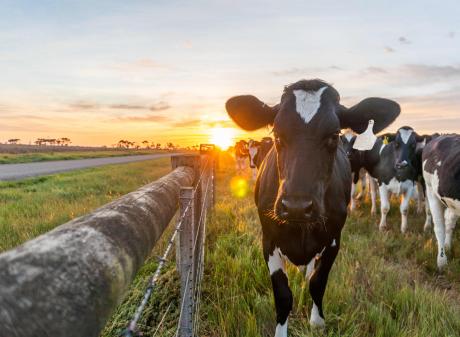
Sharemilkers Nick and Anieka Templer have taken their first step to farm ownership.
Their fully self-contained system includes a 228ha effective dairy platform in St Patricks, near Balfour, a 145ha lease block nearby and an 86ha run-off block in Lumsden.
They bought the Lumsden block on the day of the CRV field day, March 19.
Their announcement sparked applause from the more than 60 people at the CRV field day.
About 710 cows were wintered on baleage and grass. On average, the cows each produced more than 560kg of milksolids last season.
This season, the herd was on track to producing 600kg of milksolids per cow. There had been no major changes in the system except more supplementary feed being given to the herd this season due to a wet spring.
A goal was for the herd to produce 400,000kg of milksolids in a season and they were "pretty close" this year, Mr Templer said.
They were tracking to produce more than 390,000kg of milksolids this season.
Cows were given about 1.1 tonnes of supplementary feed in the milking shed, a mix of distiller’s dried grains, palm kernel and wheat.

The property could be dry in summer, which was why a big buffer of silage was needed.
The herd was milked twice a day and would go once a day in the last two or three days of May.
The couple began working on the farm as contract milkers in 2012.
In 2019, they bought the herd and had been 50:50 sharemilking since.
Mrs Templer said the herd was mostly Friesian, but some Jersey genetics had been introduced to reduce the stature of the cows.
Describing her ideal cow, she said it did not matter what colour or breed it was, as long as it was efficient and had a good udder to "pump the milk out", and was able to get in-calf.
A cow needed capacity to eat feed and produce milk with fat and protein.
"That’s what we get paid on," Mrs Templer said.
The six-week in-calf rate for the past 12 years had ranged between 71% and 81%.

The empty cow rate was 13% this season, an improvement on the 15% last season.
An aim is to drop that empty rate to 10% or below.
They had tried to reduce their empty rate by making changes in the breeding programme, including using the semen of beef bulls, Jersey bulls and artificial insemination only.
Cows had been wearing Allflex smart collars for two matings and reproduction results were similar to when they were not, she said.
"The collars have given us the freedom of not having to get up at 3.30am to draft cows for AI."
No bulls were used in their mating programme, relying solely on artificial insemination on their top 50 heifers from their best cows to accelerate genetic gain.
A 10-week artificial insemination programme, starting with four weeks of artificial breeding for replacements, followed by two weeks using CRV Fertabull Charolais, and finishing with four weeks of LIC short gestation length bulls.
She also incorporates international genetics, aiming to improve udder health in their herd.
They had used sexed semen from New Zealand bulls before, but they stopped because it produced 200 replacements, when only 160 were needed.

CRV grass-fed genetics manager Peter van Elzakker said CRV was part of a project developing an index on the methane efficiency of New Zealand dairy cattle, including bulls and their lactating daughters.
"That will help you guys to do some parts of your compliance," Mr van Elzakker said.
A farmer in the crowd asked if they were only creating a methane index due to pressure from the government.
Mr van Elzakker said no, international genetics companies were also investigating methane efficiency, as it was known some cattle produce more methane than others.
Farmers could use the data as a tool to meet the requirements of milk processors, which sold their products to companies targeting net-zero emissions.
CRV Oceania managing director James Smallwood said a direction of the programme was to reduce the amount of methane emissions per kg of milksolids.
The measuring of methane efficiency was "very much market driven".
A milk processor was rewarding farmers on emissions efficiency, so CRV were providing their customers with a way to earn more money.
"If we didn’t, we’d be missing something," Mr Smallwood said.

Where: St Patricks near Balfour in Northern Southland.
Owners: Nick and Anieka Templer.
Type: 50:50 sharemilkers.
Cows wintered: 710 cows.
Herd: Mostly Friesian cross.
Average liveweight: Between 520kg and 530kg.
Milk production for 2023-24:
Per cow: 566kg of milksolids.
Per hectare:1640kgMS/ha.















